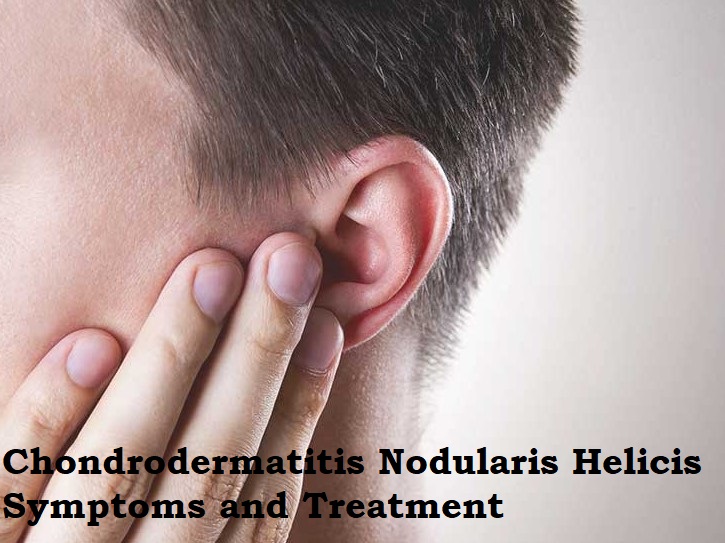Chondrodermatitis nodularis helicis (CNH) is a harmless condition that affects the skin and ligament of the pinna. CNH also refers to Winkler illness, named for the dermatologist who first described the condition in 1915. It was subsequently characterized in 1918 by Foerster, who also framed the tiny, clinical, and treatment subtleties of the condition.
This condition usually affects the helix of the pinna, however, in specific cases, the antihelix may also be affected. Consequently, some have proposed renaming the condition chondrodermatitis nodularis auricularis. Chondrodermatitis nodularis helicis, ear pressure bruises, and chondrodermatitis nodularis antihelicis are all names for the condition.

Table of Contents
What are the Clinical Highlights of Chondrodermatitis Nodularis?
Chondrodermatitis nodularis is a single, firm, and oval knob, 4-6 mm in breadth, with focal covering and encompassing erythema.
In men, the most widely recognized site for CNH is the helix, while in women it is more commonly found on the antihelix. Usually one-sided and locate on the resting side, but can be two-sided as well. CNH is excruciating and delicate. An evening of torture might keep you from falling asleep on the impacted side. The sore can drain or release a small amount of textured material.
What Are the Symptoms?
- The clearest side effect is an excruciating raised knock or knob on the eardrum.
- The knob will usually grow larger over time until it is somewhere in the range of 5 and 10 millimeters (mm) in measurement.
- There is often a minuscule center in the knock that radiates a textured fluid. This fluid might leave a scab structure over the knob when it dries.
- However, a knob manufactured by CNH is typically delicate to contact and temperature. It can become extremely sharp or painful when bothered or infected with a cold.
- It is impossible to dispose of CNH by picking at a knob. The knot might persist for a long time.
How Could it be Analyzed?
A dermatologist or specialist might be able to analyze CNH by checking the ear out.
They will, however, likely request a biopsy to confirm this and rule out more significant circumstances. During a biopsy, a specialist will remove a small piece of the knob, and send it away for assessment under a magnifying lens.
Some individuals botch CNH because they mistake it for malignant growth, in particular, if the skin around the knob drains or becomes layered. This disarray is because basal cell skin disease, squamous cell skin malignant growth, and precancers can look like some CNH knobs.
Reasons for Chondrodermatitis Nodularis Helicis
Individuals foster CNH for various reasons. In some cases, it does not seem to provide any obvious explanation. A few potential causes include:
- Resting reliably on one side, which can be a wellspring of tension or bothering on one ear compromise blood supply to the ligament openness to outrageous chilly climate ear injury because of use of earphones, phones, or portable amplifier gadgets delayed sun openness throughout life, as indicated by certain hypotheses
- The skin condition cannot be transmitted by any kind of microorganism or infection. Men over the age of 40 are probably more likely to foster CNH, but women can also suffer from it. There have also been a few interesting stories about kids encountering CNH.
- Nevertheless, there is not much research into the actual development. There is no proof that CNH is infectious and no microscopic organisms or infections are associated with the presence of CNH.
How is Chondrodermatitis Nodularis Helicis Treated?
The most well-known treatment for CNH used to be a medical procedure. The medical procedure involves removing the entire knob from the individual’s ear. During the removal procedure, nerves slice to eliminate the agonizing sensations around the papule. Indeed, even after a medical procedure, CNH might return in a similar region of the ear. This is especially true if the medical procedure neglects to eliminate all the kinked ligaments under the knob.
The repeat rate after this kind of medical procedure is around 10-30 percent, as indicated by one review.
New research has shown that safer treatments for CNH might have a similar general repeat rate. Along these lines, it could be smarter to avoid medical procedures whenever possible.
Options in contrast to a medical procedure can include:
- Laying down with a custom pad made for individuals with CNH applying a skin dynamite treatment. Freezing the knob with nitrogen and getting laser or photodynamic treatment
- Laying down with a custom pad or froth prosthesis is one of the suggested strategies for treating the aggravation that comes from resting on the knobs. Specialty cushions that have an opening in them where the ear would some way or another smooth against the pillowcase sell specifically for individuals that have CNH. A few people feel that for however long they can rest and not feel torment or tension, that is all the treatment that they need for their CNH.
- An additional approach is to apply skin dynamite to the knob of the ear. According to one review, dynamite apply to the ear with a fix. Studies showed that, following a fixed treatment for some time, blood vessels developed in the knob region. This could lead to a reduction in size.
- The dermatologists might decide to freeze the knob with nitrogen or treat it with a course of cortisone infusions. Laser treatment is also successful.
- Your clinical history, your comfort level with various types of treatment techniques, and the treatment experience of your dermatologist consider while choosing how to treat your CNH.
Could Chondrodermatitis Be Prevented?
To stop chondrodermatitis from returning or advancing, take the following steps:
- Stay away from immediate or delayed strain on the impacted ear.
- Try not to rest on the impacted ear if at all possible.
- Use a delicate pad or cut an opening in your pad to ease tension on your ear.
- Lay down with a rankle-type wrap for cushioning. Keep away from sun openness.
- Wear a warm cap to try not to open your ears to the virus
FAQs
Chondrodermatitis will not disappear all by itself, but it does not generally cause other medical conditions. In any case, there are a few interesting inconveniences that might show up while treating it or while leaving it untreated, for example, Loss of rest and increased distress. Disease caused by damaged skin and uncovered ligaments.
The mean duration of the CDNH was 11.6 months (range, 6 two years).
For patients with chondrodermatitis nodularis chronica helicis (CNH), visualization is excellent, although long-term dismalness is normal. An unconstrained goal is to receive an exemption; abatements may occur, but chondrodermatitis nodularis chronica helicis typically persists unless many cases resolve.
